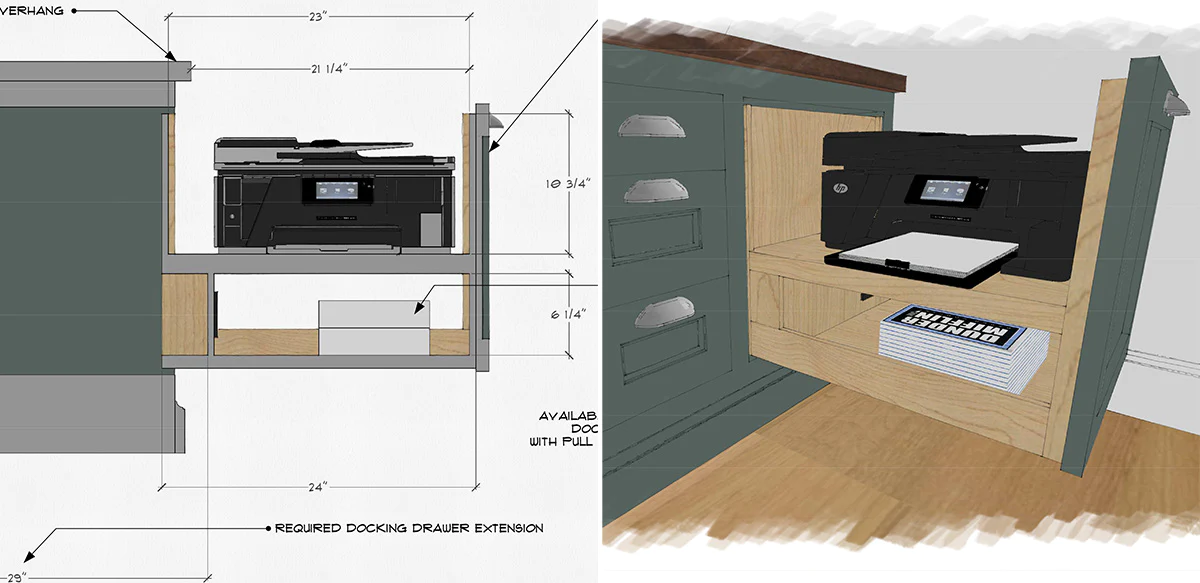

software used:


premise
Through a partnership with the University of Illinois Chicago and the Illinois Secretary of State’s Office, The UIC School of Design’s DES 420 course was a year-long studio that was used to redesign and revitalize the experience of both customers and employees at Illinois DMV locations. Much of the project was graphic and experience design oriented, aiming to redesign DMV logos, graphics, artwork, flyers, iconography, etc. A small team of 4 industrial design students was formed, however, to redesign and improve Illinois’s mobile DMV units, which are mainly used to bring certain DMV services (license renewal, sticker renewal, state IDs) to different locations, such as conventions, shows, universities, etc.

current setup
The current version of the Illinois Mobile DMV units is fairly disorganized. As shown in the image to the left, DMV employees wheel the necessary equipment in on dollies. The equipment is stored in multiple sized boxes, all of which are left either stuck in a random corner of the room being used, or just to the side of the tables in use. The Secretary of State’s desire was to improve the DMV’s image while also maintaining a professional image, and therefore, my teammates and I quickly identified that this loose stack of boxes impeded the professionalism that was desired.
This sentiment that the current setup appears messy and unprofessional was only supported by rapidly identifying the lack of cable management. Because the mobile DMV units make use of whatever tables are provided by the location they are visiting, cable management is nearly impossible and impractical to maintain. This was a point we felt needed to be addressed by our solution.


We also found that while not detrimental to the mobile units, the layout of seating for the customers and the placement of the table cloth made it so that it was harder to identify for passerbys as the DMV when customers were seated in front of the Secretary of State’s logo.
inspiration + project objective
Our solution was to consist of a few targeted attributes:
- Mobility
- Storage
- Modularity
- Professionalism
- Durability
- Organization
- Structure
Our team’s goal was to create an efficient unit for the mobile DMV employees that could easily transport all the required equipment to and from sites, provide a working space for employees, maintain a professional and organized appearance, and successfuly brand the presence of the mobile DMV without disruption.






parameter identification

In order to properly design a unit, certain parameters needed to be indentified:
Size of the equipment being used by the mobile DMV units -
Space in possible transport vehicles -
Average and minimum sizes of general spaces across Illinois -
Average workspace sizes -
We identified the common equipment used by the mobile DMV clerks. This included the following:
Lexmark MS421 (Printer) -
Brother HLL 6200 DW (Printer) -
Xerox Duplex Combo Scanner (Desktop Document Scanner) -
Topaz T-LBK460 (Signature Pad) -
The measurements of each piece of hardware are shown on the left, in the order of height, width, then depth, each measured in inches.
For the transport vehicles, at the time this project started, we did not know which vehicles were employed by the Secretary of State’s Office, so we based our design on the cargo capacity of the smallest available Ford Transit van (we were later informed that the Secretary’s Office acquired the largest trim Ford van).
For the general spaces, we mainly needed to insure our unit could fit in elevators. To check this, we researched the minimum elevator size requirements in the US as required by the Americans With Disabilities Act (ADA). This gave us two crucial measurements: the minimum door width, being 36 inches, and the minimum elevator car depth, being 51 inches.
Size of the equipment being used by the mobile DMV units -
Space in possible transport vehicles -
Average and minimum sizes of general spaces across Illinois -
Average workspace sizes -
We identified the common equipment used by the mobile DMV clerks. This included the following:
Lexmark MS421 (Printer) -
Brother HLL 6200 DW (Printer) -
Xerox Duplex Combo Scanner (Desktop Document Scanner) -
Topaz T-LBK460 (Signature Pad) -
The measurements of each piece of hardware are shown on the left, in the order of height, width, then depth, each measured in inches.
For the transport vehicles, at the time this project started, we did not know which vehicles were employed by the Secretary of State’s Office, so we based our design on the cargo capacity of the smallest available Ford Transit van (we were later informed that the Secretary’s Office acquired the largest trim Ford van).
For the general spaces, we mainly needed to insure our unit could fit in elevators. To check this, we researched the minimum elevator size requirements in the US as required by the Americans With Disabilities Act (ADA). This gave us two crucial measurements: the minimum door width, being 36 inches, and the minimum elevator car depth, being 51 inches.
sketch ideation: initial
When first approaching the idea of an improved mobile DMV unit, we held mobility to a high standard. Because of this, the majority of our ideation took the form of a cart, while other versions were more of a collapsable unit that could be loaded onto a cart. Overall, however, a purpose-built cart felt more natural and less cumbersome.

